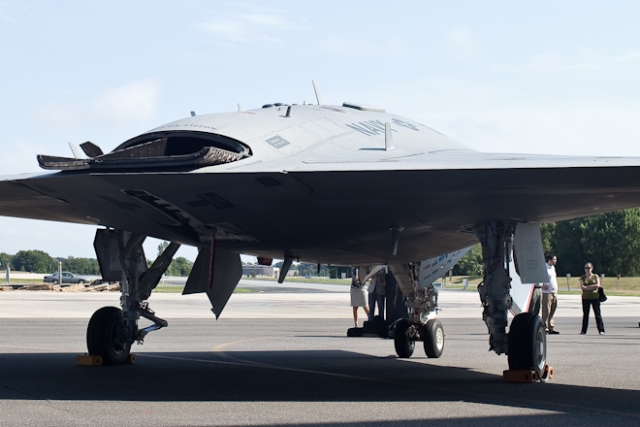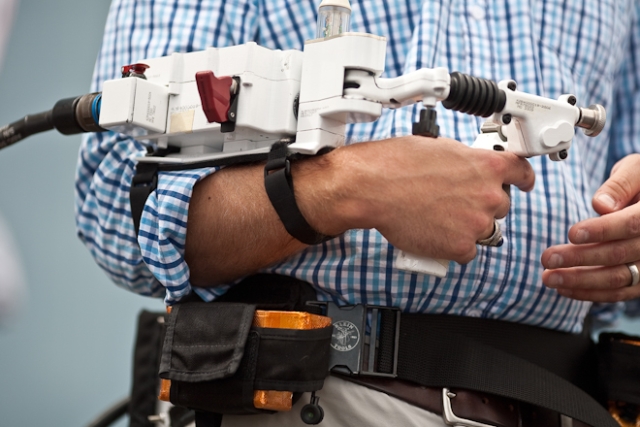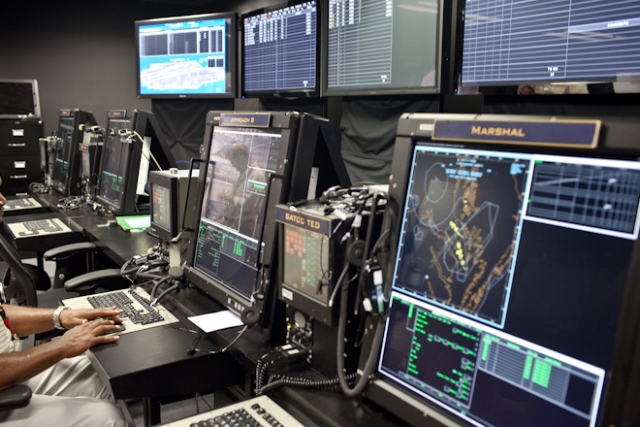 Not many people have seen the X-47B up close: its Northrop Grumman manufacturers and its remote Navy test pilots, mostly. Until Tuesday, when the Navy Programme Executive Office in charge of developing what will be known as the UCLASS — for Unmanned Carrier Launched Airborne Surveillance and Strike System — let reporters see the X-47B in the metallic flesh.
Not many people have seen the X-47B up close: its Northrop Grumman manufacturers and its remote Navy test pilots, mostly. Until Tuesday, when the Navy Programme Executive Office in charge of developing what will be known as the UCLASS — for Unmanned Carrier Launched Airborne Surveillance and Strike System — let reporters see the X-47B in the metallic flesh.
First impression: It’s a lot bigger than the photos and music videos have made it out to be. Its 62.1 feet of bat-shaped wingspan look even larger in person. When it stands on its landing gear, you get the sense that a human being could actually crawl into the X-47B — they’d need a ladder — even though that would defeat the purpose. After all, the X-47B is designed to be one of the most autonomous unmanned aircraft that the U.S. military has.
The idea behind UCLASS — of which the X-47B is merely the demonstration model — involves doing away with the joysticks and computer banks that most remote operators use to control their aircraft. Instead, Northrop’s proprietary software lets UAS pilots programme where they want the aircraft to fly.“It’s smart enough for you to put really interesting contingencies” in the X-47B’s way, says Captain Jaime Engdahl, the Navy’s Programme Manager for Unmanned Aircraft. “It has the smarts to react to that condition.”
The Navy doesn’t really want to elaborate, beyond saying that “precision GPS” helps the aircraft understand where its aircraft carrier mothership is. The Navy is quick to remind reporters, however, that the X-47B is just a demonstrator, unarmed and carrying no sensors yet. It’s at Pax River, home to catapults and trapping wires that simulate what’s necessary for an aircraft launch, to test the proposition that the Navy really can launch an unmanned aircraft from a carrier and bring it safely back. The aircraft took its first flight from Pax River on Sunday, a 35-minute flight over the Chesapeake Bay at 7,500 feet and a 180-knot clip.
Next year, the Navy plans to actually launch the X-47B from Pax River to the deck of an aircraft carrier — with the aforementioned mouse click. The plan is to bring UCLASS into the Navy’s air fleet by 2019 (the date recently slipped a year).
That said, not even an unmanned aircraft as autonomous as the X-47B is without human companionship. A Northrop test pilot named Gerrit Everson can prove it: on his forearm is a white box called the Control Display Unit. Packed with six buttons and cabled to a battery pack strapped to the small of Everson’s back, it’s kind of like if Nintendo created a Power Glove for flight-deck operations. The control unit can power the aircraft up once it’s latched to a carrier catapult and take control of it once it lands and needs to be moved elsewhere on the carrier. Everson grips a handle and flicks his wrist; if the X-47 was powered up, its nose would along with his wrist.

The control display unit for the X-47B is used to guide the aircraft during aircraft carrier taxiing. It does not use the control to take off
Another thing the Navy’s got to test is just how an aircraft carrier’s crew works with a robotic plane. There’s little margin for error in flight deck operations, and so far, sailors only know how to interact with human pilots. At Pax, a commander named Jeff Dodge explains how the Navy has “digitized an aircraft carrier” so the X-47B can better understand all the other stuff that occurs on the flight deck, in order to integrate it with manned flights.
There’s even a dongle that Dodge calls a “Pickle Stick”: something that can send wave off the X-47B if the robot looks like it’s not going to land on the carrier at the right angle.
Underneath the bulbous, beak-like nose cone — what you might call the jowls of the aircraft, there’s a second set of doors behind the landing gear. That’s the payload bay, where the plane can carry two 2,000-pound bombs.
The rest of the aircraft is weirder than meets the eye. Calling it a mini-stealth bomber, a common description, doesn’t really do it justice. It’s got something of a pot belly and a hunched back. Its wings don’t taper flat, they bulge out like a flexed bicep and out a second time near the wingtips. In place of a cockpit is a red slit — an air intake — that makes the machine look like a Cylon Raider from Battlestar: Galactica. It may be on an aircraft carrier before the decade ends, but it’s not crazy to think the X-47B seems otherworldly.
Photos: Jared Soares/Wired
Source: Wired:Danger Room

